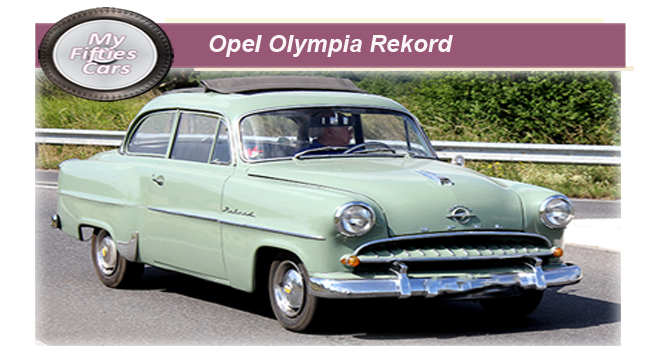
When Opel introduced their two-door family saloon the Olympia Rekord P1 as a replacement for the original Olympia in March 1953, the increasing influence of parent company General Motors was there for all to see.
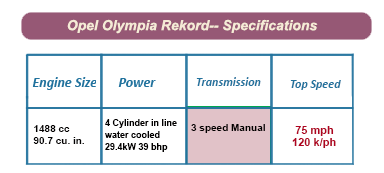 From the outset, the Olympia Rekord P1's Ponton format bodywork incorporated a wide variety of Detroit inspired styling features emphasised by the almost obligatory lashings of chrome decoration, evenly spread between the exterior and exterior of the vehicle.
From the outset, the Olympia Rekord P1's Ponton format bodywork incorporated a wide variety of Detroit inspired styling features emphasised by the almost obligatory lashings of chrome decoration, evenly spread between the exterior and exterior of the vehicle.
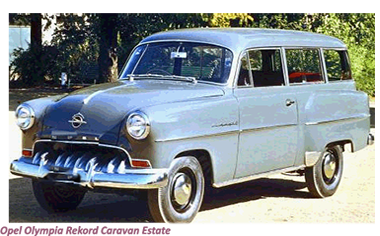 WWhile the Opel design team had the best of intentions when creating the Olympia Rekord, it soon became apparent that all that chrome was out of place on such a compactly modest car as the P1 giving it a wholly disproportionate look.
WWhile the Opel design team had the best of intentions when creating the Olympia Rekord, it soon became apparent that all that chrome was out of place on such a compactly modest car as the P1 giving it a wholly disproportionate look.
Although the wraparound screens, tailfins, and chrome adornments might have looked spectacular on larger models on a small saloon, the effect was only one of a car with an identity crisislooked confused.
 The media observed that the vehicle's stubby bodywork seemed at odds with the curved front and rear screens, while the oversized radiator grille made the Olympia PI look like a cheap caricature of some of the GM United States more overstated offerings.
The media observed that the vehicle's stubby bodywork seemed at odds with the curved front and rear screens, while the oversized radiator grille made the Olympia PI look like a cheap caricature of some of the GM United States more overstated offerings.
Despite being something of an ugly duckling, the Olympia Rekord P1 had so many other positive factors going for it that it could not help being a tremendous commercial success with over 1.5 million cars marketed in the six years that the car was in production.
![]()
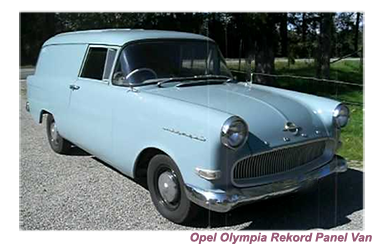 Sales were given a considerable boost in 1958 when Opel announced the launch of a multi-function estate car, marketed as the `Caravan.'
Sales were given a considerable boost in 1958 when Opel announced the launch of a multi-function estate car, marketed as the `Caravan.'
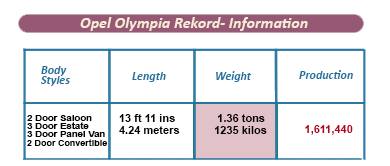 The Olympia Rekord Caravan continued with the same design theme of a car that looked that it had shrunk in the car wash.
The Olympia Rekord Caravan continued with the same design theme of a car that looked that it had shrunk in the car wash.
The pluses that the Olympia Rekord did offer to compensate for its awkward stance was its exceptionally competitive opening price.
The Olympia Rekord opening price was considerably influenced by the size of the engine fitted, with Opel offering a wide choice, starting from the standard 1488 cc four-cylinder water-cooled overhead-valve unit, which came as standard.
Potential although buyers could choose from a new 1205cc (74 cu in) overhead-valve engine or a more lively 1680cc (103 cu in) unit, later fitted in the Rekord P2.
 One other radical step that Opel took with the Olympia Rekord, influenced again by GM, was applying an annual cosmetic update, usually entailing fitting a new grille as well as a few other items of ancillary trim.
One other radical step that Opel took with the Olympia Rekord, influenced again by GM, was applying an annual cosmetic update, usually entailing fitting a new grille as well as a few other items of ancillary trim.
![]()
This policy of annual facelifts acted as a double-edged sword for Opel, firstly by always ensuring that the model would still be at the forefront regarding publicity, guaranteeing that dealers would always have something to talk about, something that their competitors found difficult to do, as updates were few and far between.
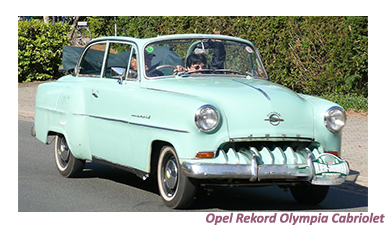 This constant attention paid dividends for Opel with the Olympia Rekord beaten only for the top slot in the best selling list in West Germany by the enigmatic and less expensive Volkswagen Beetle, which was both much smaller, less costly and barely saw an update.
This constant attention paid dividends for Opel with the Olympia Rekord beaten only for the top slot in the best selling list in West Germany by the enigmatic and less expensive Volkswagen Beetle, which was both much smaller, less costly and barely saw an update.
 Always a steady seller, the Olympia Rekord remained in production well into the Sixties, replaced by the Opel Rekord Series A in 1963.
Always a steady seller, the Olympia Rekord remained in production well into the Sixties, replaced by the Opel Rekord Series A in 1963.
It may not have been too symmetrical, but with the Olympia Rekord that Opel established a market niche that would remain in control of for many decades, through providing clean and comfortable cars that offered tremendous value for money.


